
前言
因為這期學期上半我選了機器學習與數據挖掘,我在課程小組項目中負責了爬蟲這個部份,我會在這篇文章紀錄一下我的過程,並教導大家如何實戰 Python 爬蟲。
項目說明
我們這個小組項目的爬取需求是爬取 Github 項目的各個特徵,這篇文章會分兩個部份,第一個部份是使用 BeautifulSoup 爬取原生的 HTML 頁面,第二部份是使用 Github API,其中第二部份包含了每個倉庫的 Commits、pull_request 等月變化量(2020.03 ~2021.03)。
P.S. 其實是我在剛開始寫爬蟲的時候,覺得 GIthub API 回傳的數據特徵有點少,所以就直接爬 Github 原生 HTML 頁面,沒有去爬月變化的數據,結果組長說要我重新去寫爬蟲,要爬月變化數據。
開發前準備
安裝相關庫
因為我們需要使用到的庫有 BeautifulSoup 和 requests 等。所以有些需要自己去安裝,
import requestsimport timeimport csvimport jsonfrom bs4 import BeautifulSouppip install requests BeautifulSoupGithub 私人 Token
因為我們需要爬取 Github 的網頁和使用 Github API,我們需要申請 Personal token,避免我們的請求達到 Rate Limit,Github 有限制一分鐘內的請求次數。

請求設定
我們請求在請求頁面時需要模仿瀏覽器的請求方式
如果自己沒有 proxies 可以去掉這一項。
# request settings
# tokentoken = ''
# proxyproxies = { "http": "http://127.0.0.1:7890", "https": "http://127.0.0.1:7890",}
# through Github apiheaders = { 'Accept': 'application/vnd.github.v3+json', 'Authorization': 'token {token}'.format(token = token)}
# 模仿瀏覽器請求原生頁面headers_raw_page = { 'User-Agent': 'Mozilla/5.0 (X11; Linux x86_64; rv:89.0) Gecko/20100101 Firefox/89.0', 'Accept': 'text/html,application/xhtml+xml,application/xml;q=0.9,image/avif,image/webp,*/*;q=0.8', 'Authorization': 'token {token}'.format(token = token)}
timeoutSec = 15 # setup your timeout spec(sec)第一部份 - 原生頁面
確定爬取規則
先確定要爬的數據,我們預先在 Github topic 中爬取 deep-learning 的相關 Repositories 的 URL 作為我們數據分析的數據量。並且觀察頁面的請求與分頁。
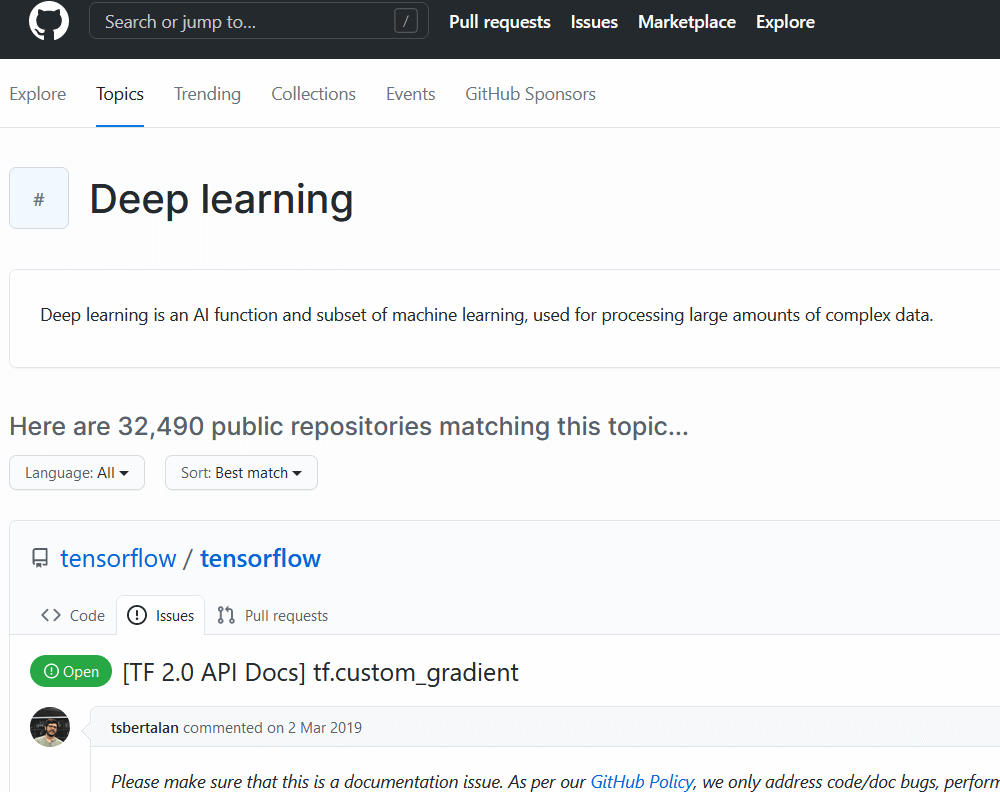
我們可以按下 F12 可以在網路請求部份找到我們頁面請求的內容,並且在傳參部份找的到 page 參數,page 參數以及 per_page 參數可以作為我們循環請求的依據。
per_page 參數是決定每頁顯示多少列倉庫,這部份是我在看完 Github API 後知道的參數。

爬取我們要的所有倉庫
下面是使用迴圈去調參,接著使用 BS4 去解析頁面元素。爬取的內容會存到 start_urls。
start_urls = [] # save urlsbase_url = "https://github.com/topics/deep-learning?page="allowed_domains = "https://github.com"
print("\n------------start grabbing all urls--------------------------\n")
for i in range(1, 35): try: html = requests.get(base_url+str(i), headers=headers_raw_page, proxies=proxies, timeout= timeoutSec) except Exception as e: print(e) print('fail to get request from ip via proxy')
soup = BeautifulSoup(html.text, "html.parser") # print(soup.prettify()) # urls = soup.find_all("a", {'class': 'text-bold'})
for j in soup.find_all("a", {'class': 'text-bold'}): start_urls.append(allowed_domains + j['href']) print(allowed_domains + j['href'])
time.sleep(1.5)細爬每個倉庫特徵
由於我們一開始爬的倉庫特徵並不是很夠,我們需要去細爬我們每個倉庫的更多數據特徵,接著我們根據 start_url 存的內容去爬取需要的倉庫細節。

print(start_urls)print("The data length: ", len(start_urls), "\n")
result = []labels = ['name', 'star', 'commits', 'fork', 'issues', 'pull_requests', 'branches', 'tags']
print("\n------------start grabbing data--------------------------\n")time.sleep(1.5)
i = 1
for url in start_urls: try: html = requests.get(url, headers=headers, proxies=proxies, timeout= timeoutSec) except Exception as e: print(e) print('fail to get request from ip via proxy') # print(html) soup = BeautifulSoup(html.text, "html.parser") # star = soup.findall("a", text="starred") # print(soup.prettify()) item = {} item['name'] = url print("all: ", len(start_urls), "index ", i, ", start: ", item['name']) i+=1 num = soup.find_all("a", {'class': 'social-count'}) # print(num) # print('\n') item['star'] = num[0] item['fork'] = num[1]
num = soup.find_all("span", {'class': 'd-none d-sm-inline'}) # print('\n') # print(num) if(len(num) == 2): item['commits'] = num[1] else: item['commits'] = num[0]
num = soup.find_all("span", {'class': 'Counter'}) # print('\n') # print(num)
item['issues'] = num[1] item['pull_requests'] = num[2] # item['contributors'] = num[7] # item['projects'] = num[4] # item['security'] = num[5]
num = soup.find_all("a", {'class': 'Link--primary no-underline'}) # print('\n') # print(num) item['branches'] = num[0] # item['release'] = num[1] # item['used_by'] = num[3]
# num = soup.find_all("span", {'class': 'Counter'}) # item['contributors'] = num[4]
num = soup.find_all("a", {'class': 'ml-3 Link--primary no-underline'}) # print('\n') # print(num) item['tags'] = num[0]
print("end", item['name'], "\n") # print("\n", item['commits']) result.append(item) time.sleep(1.5)存成 CSV
我們接下來根據 labels 去存成 CSV 文件。
print("\n------------start saving data as csv--------------------------\n")
try: with open('csv_dct.csv', 'w') as f: writer = csv.DictWriter(f, fieldnames=labels) writer.writeheader() for elem in result: writer.writerow(elem) print("save success")except IOError: print("I/O error")第二部份 - Github API
確定爬取需求
我們需要的是各語言的熱門 repository,每個倉庫的最終 name、language、stargzers、forks、open_issues、watchers、readme,以按照月份變化(2020.03 ~2021.03)的 commits、pull requests、forks、issues events。
為了求方便 我們需要使用 GIthub 提供的 API 進行爬取,然而 Readme 部分需要去爬取原生的 HTML 頁面。
確定爬取後需要分成三張表,基本數據 gitub_basic.csv;月變化數據 github_commits.csv、github_pull_requests.csv。(後面因為 forks 和 issues 的樂變化數據爬取過多,拖長每個 repo 的數據處理進度,導致平均一個 repo 需要爬取 8 mins 左右,所以棄掉這兩項月變化數據)
先查看 Github API
我們先查看 Github 提供的 API 文檔。
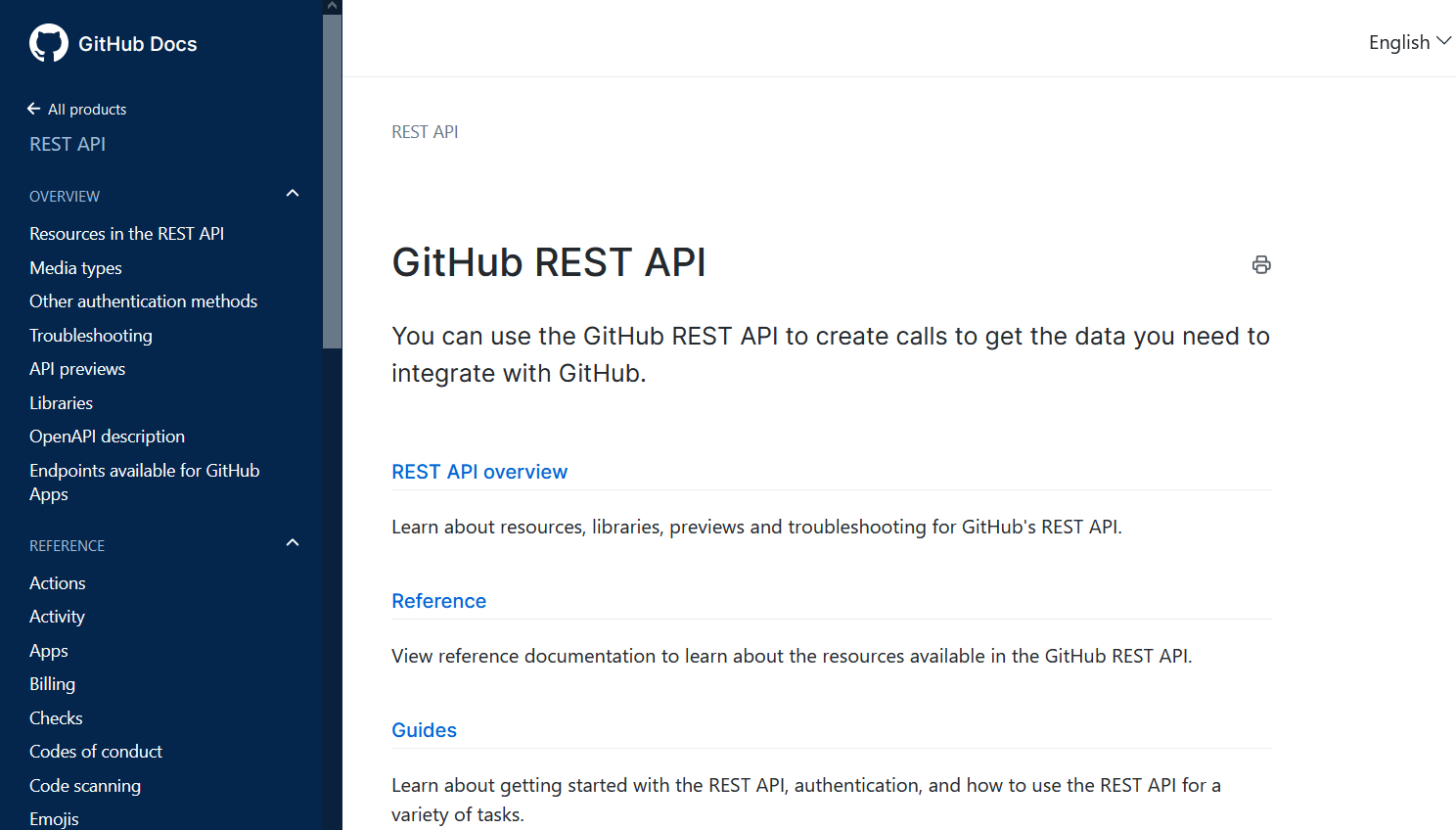
我們首先需要用到的 API 是 Search 裡面的 https://api.github.com/search/repositories。
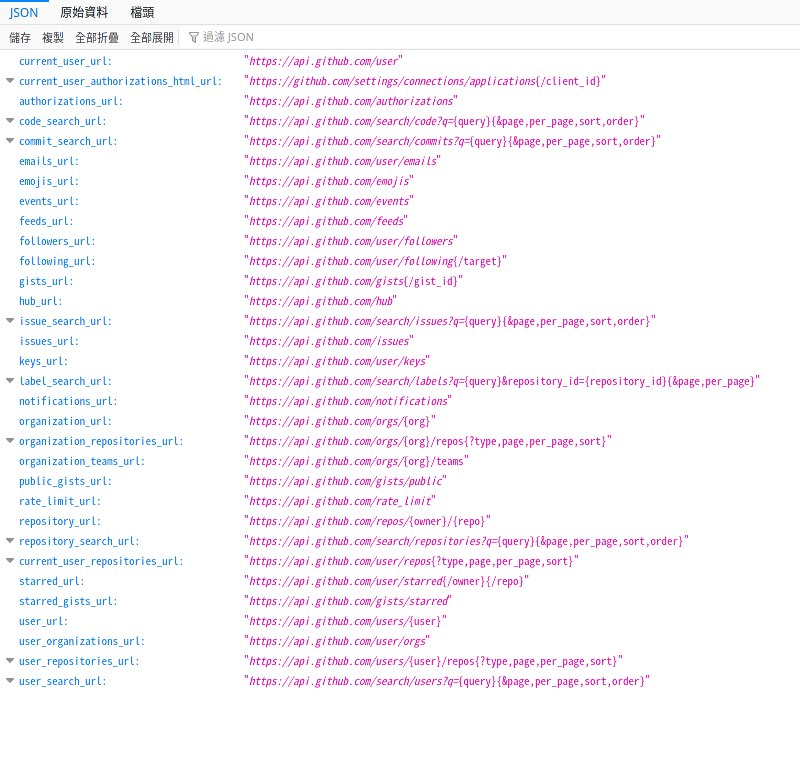
我們先測試一下 API:
你也可以使用 Postman 去做測試,因為有時回傳值太長了,終端機直接砍掉前面部份。
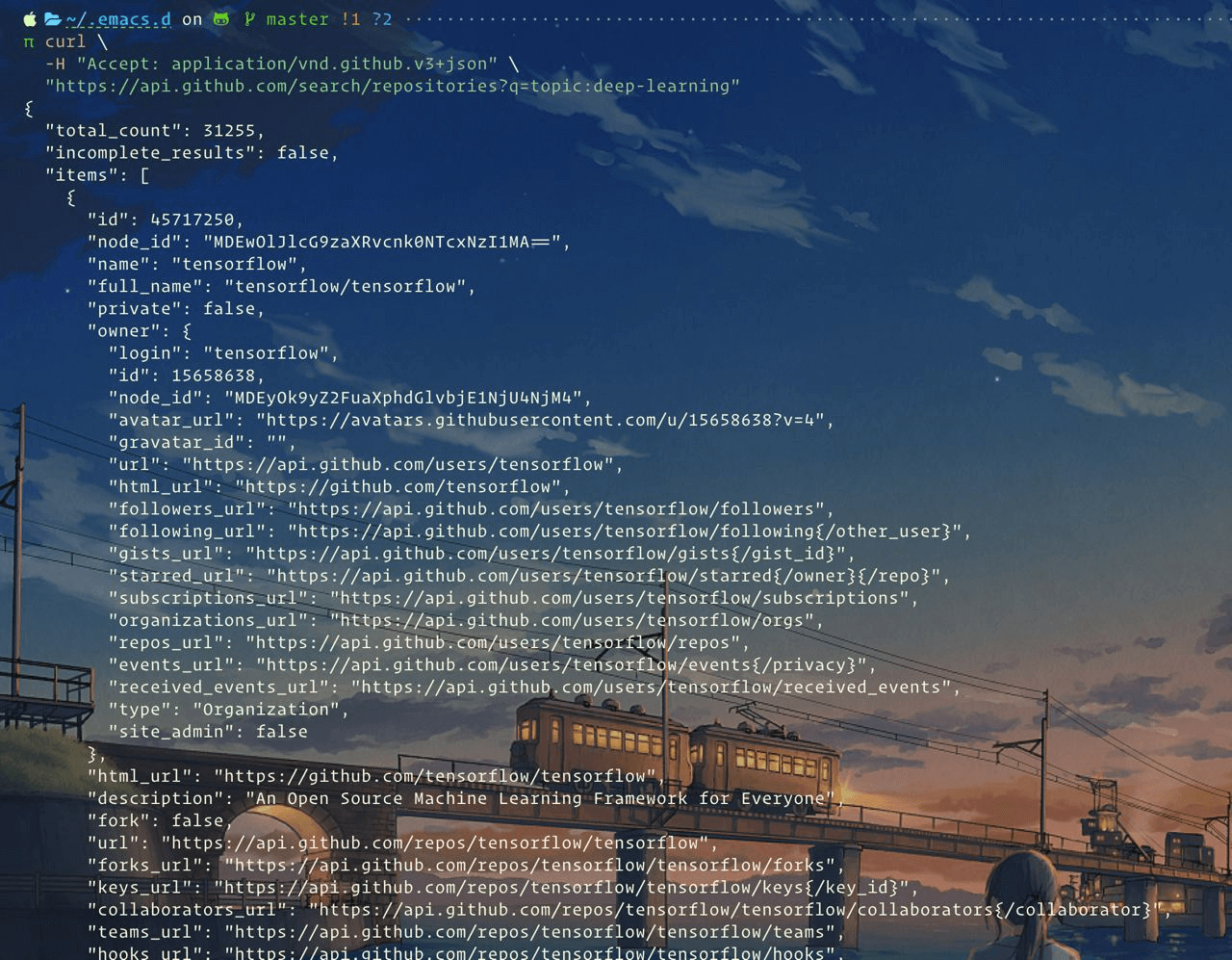
確定特徵
因為我們使用 Github API 回傳的數據特徵已經有
- name
- language
- stargazers
- forks
- open_issues
- watchers
以及各種請求 URL(作為後面爬取各),雖然特徵沒有第一部份爬取 HTML 頁面的數據特徵多,但作為數據分析特徵夠了。
編寫爬取類
編寫爬蟲類的成員變量,與構造函數。並且使用 Github search repositories 的 API 分別,總共的語言有 python、java、golang、js。
其中
- repositories: 爬取的 repo
- basic_table: repo 的基本特徵
- commits_table: 每個 repo 的 commits 月變化數據
- pull_requests_table: 每個 repo 的 pull requests月變化數據
- forks_table: 每個 repo 的 forks月變化數據
- issues_table: 每個 repo 的 issues月變化數據
- basic_url: 根據爬取語言熱門 repos 的爬取 api
- basic_labels: basic_table 存成 csv 文件的標籤
- template_labels: 月變化數據存成 csv 文件的標籤
- template_table: 月變化數據初始化賦值模板
class github_grab(object): def __init__(self): self.repositories = [] self.basic_table = [] self.commits_table = [] self.pull_requests_table = [] self.forks_table = [] self.issues_table = [] self.base_url = [ "https://api.github.com/search/repositories?q=language:python&sort=stars", "https://api.github.com/search/repositories?q=language:java&sort=stars", "https://api.github.com/search/repositories?q=language:c&sort=stars", "https://api.github.com/search/repositories?q=language:golang&sort=stars", "https://api.github.com/search/repositories?q=language:js&sort=stars" ] self.basic_labels = [ 'name', 'language', 'stargazers' , 'forks', 'open_issues', 'watchers', 'readme' ] # commits pull_requests forks issues_events self.template_labels = [ 'name', '2019_01', '2019_02', '2019_03', '2019_04', '2019_05', '2019_06', '2019_07', '2019_08', '2019_09', '2019_10', '2019_11', '2019_12', '2020_01', '2020_02', '2020_03', '2020_04', '2020_05', '2020_06', '2020_07', '2020_08', '2020_09', '2020_10', '2020_11', '2020_12', '2021_01', '2021_02', '2021_03' ]
self.template_table = { 'name': '', '2020_03': 0, '2020_04': 0, '2020_05': 0, '2020_06': 0, '2020_07': 0, '2020_08': 0, '2020_09': 0, '2020_10': 0, '2020_11': 0, '2020_12': 0, '2021_01': 0, '2021_02': 0, '2021_03': 0 }爬取我們需要的所有熱門倉庫
根據爬取類的 baseURL 遍歷請求,由於怕數據量太大,爬取過久,所以我們每個語言的熱門倉庫只爬取 40 個,總共會爬取 200 個倉庫。每次請求都需要設定如果爬取回來的狀態碼如果是 403,則需要等待 1 分鐘繼續爬取,如果是 404 或是 204 則代表資源不存在。
class github_grab(object): # ... def get_all_repositories(self): print("\n------------start grabbing all repositories--------------------------\n") index = 1 for url in self.base_url: print("\nbase url : " + url + "\n") for i in range(1, 5): try: req = requests.get(url + "&page=" + str(i) + "&per_page=100", headers=headers, proxies=proxies, timeout=timeoutSec) if(req.status_code == 403): print("Rate limit, sleep 60 sec") time.sleep(60) i -= 1 continue elif(req.status_code == 404 or req.status_code == 204): print('The source is not found') continue items = req.json()['items'] # temp = json.loads(req) # print(type(req)) print("req len " + str(len(items))) self.repositories += items print('grab page ' + str(index) + ', current repository quantity : ' + str(len(self.repositories))) index += 1
# print(self.repositories) except Exception as e: print(e) print('fail to get request from ip via proxy')
# sleep # time.sleep(2)編寫 Readme 爬取方法
由於每個倉庫的 readme 的文件名都不一樣,所以我只要以文件名是 readme 或 README,文件類型是 *.md 或 *.rst,如果還有其它的命名方式,我們可以認為該倉庫的文件命名不規範,不需加入考量。這裡的爬取使用 BS4。
class github_grab(object): # ... def get_repository_readme(self, url): print("start to get " + url + " readme") try: req = requests.get("https://github.com/" + url + "/blob/master/README.md", headers=headers_raw_page, proxies=proxies, timeout=timeoutSec) if(req.status_code == 403): print("Rate limit, sleep 60 sec") time.sleep(60) req = requests.get("https://github.com/" + url + "/blob/master/README.md", headers=headers_raw_page, proxies=proxies, timeout=timeoutSec) elif(req.status_code == 404 or req.status_code == 204): print('The source is not found') # print(type(req)) soup = BeautifulSoup(req.text.replace('\n', ''), "html.parser") num = soup.find_all("div", {'id': 'readme'}) # print(req) # print("req len " + str(len(req))) # time.sleep(2) return num[0] if len(num) >= 1 else ""
except Exception as e: print(e) print('fail to get request from ip via proxy')編寫處理所有的 repo 方法
由於我們在前面在 get_all_repositories 類方法已經將很多基本數據爬下來,所以我們 basic 部分不需要進一步爬取,月變化數據需要另外寫類方法處理。
class github_grab(object): # ... def deal_with_repositories(self): print("-------------------start to deal with repo\'s data----------------------\n") i = 1 for repo in self.repositories: print('deal with the ' + str(i) + ' / ' + str(len(self.repositories)) + " " + repo['full_name']) i += 1 # basic_table basic_temp = {} basic_temp['name'] = repo['full_name'] basic_temp['stargazers'] = repo['stargazers_count'] basic_temp['watchers'] = repo['watchers_count'] basic_temp['language'] = repo['language'] basic_temp['forks'] = repo['forks_count'] basic_temp['open_issues'] = repo['open_issues'] basic_temp['readme'] = self.get_repository_readme( repo['full_name']) self.basic_table.append(basic_temp) # commits_table # init use copy temp = self.template_table.copy() # print('init temp') # print(temp) temp['name'] = repo['full_name'] temp = self.get_repository_commits(temp) # print(temp) self.commits_table.append(temp) # print("-----") # print(self.commits_table) # print("----")
# pull request temp = self.template_table.copy() temp['name'] = repo['full_name'] temp = self.get_repository_pull_requests(temp) self.pull_requests_table.append(temp)
# # forks # temp = self.template_table.copy() # temp['name'] = repo['full_name'] # temp = self.get_repository_forks(temp) # self.forks_table.append(temp)
# # issues_events # temp = self.template_table.copy() # temp['name'] = repo['full_name'] # temp = self.get_repository_issues(temp) # self.issues_table.append(temp)編寫月份分類方法
因為我們的月份分得較死,一時沒想到怎麼封裝,所以寫起來又臭又長。
class github_grab(object): # ... def date_classify(self, temp, date_time): # print(date_time) if("2021-03-01T00:00:00Z" <= date_time and date_time < "2021-04-01T00:00:00Z"): temp['2021_03'] += 1 elif("2021-02-01T00:00:00Z" <= date_time and date_time < "2021-03-01T00:00:00Z"): temp['2021_02'] += 1 elif("2021-01-01T00:00:00Z" <= date_time and date_time < "2021-02-01T00:00:00Z"): temp['2021_01'] += 1 elif("2020-12-01T00:00:00Z" <= date_time and date_time < "2021-01-01T00:00:00Z"): temp['2020_12'] += 1 elif("2020-11-01T00:00:00Z" <= date_time and date_time < "2020-12-01T00:00:00Z"): temp['2020_11'] += 1 elif("2020-10-01T00:00:00Z" <= date_time and date_time < "2020-11-01T00:00:00Z"): temp['2020_10'] += 1 elif("2020-09-01T00:00:00Z" <= date_time and date_time < "2020-10-01T00:00:00Z"): temp['2020_09'] += 1 elif("2020-08-01T00:00:00Z" <= date_time and date_time < "2020-09-01T00:00:00Z"): temp['2020_08'] += 1 elif("2020-07-01T00:00:00Z" <= date_time and date_time < "2020-08-01T00:00:00Z"): temp['2020_07'] += 1 elif("2020-06-01T00:00:00Z" <= date_time and date_time < "2020-07-01T00:00:00Z"): temp['2020_06'] += 1 elif("2020-05-01T00:00:00Z" <= date_time and date_time < "2020-06-01T00:00:00Z"): temp['2020_05'] += 1 elif("2020-04-01T00:00:00Z" <= date_time and date_time < "2020-05-01T00:00:00Z"): temp['2020_04'] += 1 elif("2020-03-01T00:00:00Z" <= date_time and date_time < "2020-04-01T00:00:00Z"): temp['2020_03'] += 1
return temp編寫單個 repo 月份 commits 變化
這裡主要就是需要注意要先自己使用 Postman 或是命令指令行試著請求看,檢查回傳的查詢結果的結構,還有時間的判斷,後面的月份變化爬取也是差不多這樣。
class github_grab(object): # ... def get_repository_commits(self, commits_temp): print("start to get " + commits_temp['name'] + " commits\' data") try: for i in range(1, 100000): req = requests.get("https://api.github.com/repos/" + commits_temp['name'] + "/commits?per_page=100&page=" + str(i), headers=headers, proxies=proxies, timeout=timeoutSec) if(req.status_code == 403): print("Rate limit, sleep 60 sec") time.sleep(60) i -= 1 continue elif(req.status_code == 404 or req.status_code == 204): print('The source is not found') continue # print("commits times" + str(i)) items = req.json() # if no data if len(items) == 0: break # if the time is too older if(items[0]['commit']['author']['date'] < "2020-03-01T00:00:00Z"): break if(items[-1]['commit']['author']['date'] > "2021-04-01T00:00:00Z"): continue for date_time in items: if(date_time['commit']['author']['date'] < "2020-03-01T00:00:00Z"): break commits_temp = self.date_classify( commits_temp, date_time['commit']['author']['date']) # time.sleep(2) return commits_temp except Exception as e: print(e) print('fail to get request from ip via proxy')編寫單個 repo 月份 pull requests 變化
class github_grab(object): # ... def get_repository_pull_requests(self, pr_temp): print("start to get " + pr_temp['name'] + " pull requests\' data") try: for i in range(1, 100000): req = requests.get("https://api.github.com/repos/" + pr_temp['name'] + "/pulls?per_page=100&page=" + str(i), headers=headers, proxies=proxies, timeout=timeoutSec) if(req.status_code == 403): print("Rate limit, sleep 60 sec") time.sleep(60) i -= 1 continue elif(req.status_code == 404 or req.status_code == 204): print('The source is not found') continue items = req.json() # if no data if len(items) == 0: break # if the time is too older if(items[0]['created_at'] < "2020-03-01T00:00:00Z"): break if(items[-1]['created_at'] > "2021-04-01T00:00:00Z"): continue for date_time in items: # print(date_time['created_at']) if(date_time['created_at'] < "2020-03-01T00:00:00Z"): break pr_temp = self.date_classify( pr_temp, date_time['created_at']) # time.sleep(2) return pr_temp except Exception as e: print(e) print('fail to get request from ip via proxy')編寫單個 repo 月份 forks 變化
雖然最後沒有用到這個類方法,但還是將代碼放出來。
class github_grab(object): # ... def get_repository_forks(self, forks_temp): print("start to get " + forks_temp['name'] + " forks\' data") try: for i in range(1, 100000): req = requests.get("https://api.github.com/repos/" + forks_temp['name'] + "/forks?per_page=100&page=" + str(i), headers=headers, proxies=proxies, timeout=timeoutSec) if(req.status_code == 403): print("Rate limit, sleep 60 sec") time.sleep(60) i -= 1 continue elif(req.status_code == 404 or req.status_code == 204): print('The source is not found') continue items = req.json() # print("forks times" + str(i)) # if no data if len(items) == 0: break # if the time is too older if(items[0]['created_at'] < "2020-03-01T00:00:00Z"): break if(items[-1]['created_at'] > "2021-04-01T00:00:00Z"): continue for date_time in items: # print(date_time['created_at']) if(date_time['created_at'] < "2020-03-01T00:00:00Z"): break forks_temp = self.date_classify( forks_temp, date_time['created_at']) # time.sleep(2) return forks_temp except Exception as e: print(e) print('fail to get request from ip via proxy')編寫單個 repo 月份 issues 變化
class github_grab(object): # ... def get_repository_issues(self, issues_temp): print("start to get " + issues_temp['name'] + " issues\' data") try: for i in range(1, 100000): req = requests.get("https://api.github.com/repos/" + issues_temp['name'] + "/issues/events?per_page=100&page=" + str(i), headers=headers, proxies=proxies, timeout=timeoutSec) if(req.status_code == 403): print("Rate limit, sleep 60 sec") time.sleep(60) i -= 1 continue elif(req.status_code == 404 or req.status_code == 204): print('The source is not found') continue items = req.json() # if no data if len(items) == 0: break # if the time is too older if(items[0]['created_at'] < "2020-03-01T00:00:00Z"): break if(items[-1]['created_at'] > "2021-04-01T00:00:00Z"): continue for date_time in items: # print(date_time['created_at']) if(date_time['created_at'] < "2020-03-01T00:00:00Z"): break issues_temp = self.date_classify( issues_temp, date_time['created_at']) # time.sleep(2) return issues_temp except Exception as e: print(e) print('fail to get request from ip via proxy')將所有的數據從成 CSV 文件
分別有三個 *.csv 文件,github_basic.csv 是基本的 repo 數據,其它兩個是月變化數據。這裡需要注意的是編碼方式要使用 utf-8,因為 readme 有很多中文字,如果不使用 utf-8,會報存儲錯誤。
def save_all_to_csv(self): self.save_as_csv("github_basic.csv", self.basic_labels, self.basic_table) self.save_as_csv("github_commits.csv", self.template_labels, self.commits_table) self.save_as_csv("github_pull_requests.csv", self.template_labels, self.pull_requests_table) # self.save_as_csv("github_forks.csv", self.template_labels, self.forks_table) # self.save_as_csv("github_issues.csv", self.template_labels, self.issues_table)
def save_as_csv(self, fileName, labels, table): print("\n------------start saving data as csv--------------------------\n")
# save csv try: with open(fileName, 'w') as f: writer = csv.DictWriter(f, fieldnames=labels) writer.writeheader() for elem in table: writer.writerow(elem) print("save " + fileName + " success") except IOError: print("I/O error")編寫 main 函數
if __name__ == "__main__": github = github_grab() github.get_all_repositories() print("repo len " + str(len(github.repositories))) github.deal_with_repositories() # print(github.basic_table) # print(github.commits_table) # print(github.pull_requests_table) # print(github.forks_table) # print(github.issues_table) github.save_all_to_csv()確認結果
執行文件確認運行結果。
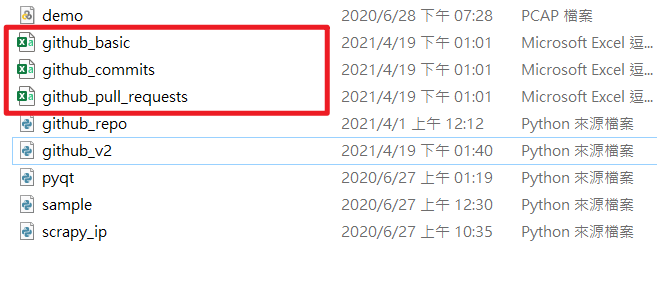
補充
Javascript 的指針問題
因為我在賦值 dict 對象時,發現如果只是普通的用 = 去賦值會導致指針問題,必須使用 dict 對象的 copy() 方法。
temp = self.template_table.copy()結語
這次的機器學習與數據挖掘的實驗我負責爬蟲的部分,由於一開始我沒有爬月變化的數據特徵,所以導致全組都在等我重新爬取新的數據,也在合作過程中發現自己的缺失,這次的工作分配讓我學到很多數據爬取的技巧,感謝大家的分工合作,最後完成了小組項目。
